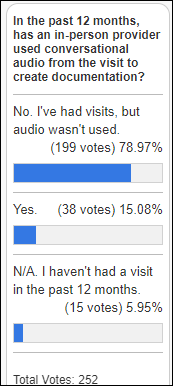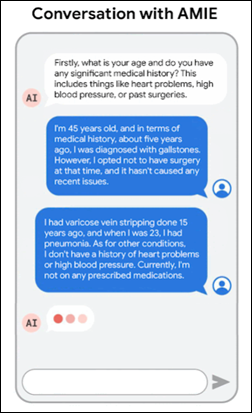Curbside Consult with Dr. Jayne 3/25/24
This weekend was targeted on catching up on some journal articles and making a continuing education plan for the next couple of months. I’ve got some new projects I’m working on that are a little bit outside my comfort zone. I know from experience that unless I make a formal plan to dig into the topics and stick to their plan, there’s a high likelihood that I’ll get pulled into firefighting projects for my clients and will never get done with the reading I feel I need.
Part of today’s effort was to read through all the articles that I’ve bookmarked in the last couple of weeks because I find them interesting, clearing them off the digital reading pile. It was a good cross section of topics and I think readers might find it interesting to see what’s on the reading list of a free-range clinical informaticist.
There were several articles from the Journal of the American Medical Informatics Association, with most of the ones I found interesting arriving in the most recent issue. The first addressed “Using artificial intelligence to promote equitable care for inpatients with language barriers and complex medical needs.” This topic resonated with me since I spent a good chunk of my training at an academic medical center in a city that served a particular refugee population that grew dramatically in the span of a few years.
The authors hypothesized that in-person interpreters are “particularly beneficial for these patients” but underused, and set out to use predictive analytics to identify the patients who should be prioritized for interpreter services. They performed semi-structured interviews with stakeholders to understand what those caring for patients thought about the idea.
I’m a big fan of qualitative research. Although one can gather a lot of information from surveys that elicit specific data points, some of the best understanding I’ve gained on complex issues has come from direct conversations with those who are involved in the issue. Stakeholder analysis is frequently overlooked when organizations are scoping large complex projects, and my feeling is that organizations neglect it at their own peril since it’s an excellent way to identify those who will support your project and those who are likely to block it. The key is having interviewers who are neutral and trusted, and making sure that people feel comfortable sharing their perspectives.
The authors conducted 49 stakeholder interviews and identified significant risks that would need to be addressed, including accuracy, privacy, and supply / demand issues. They also identified benefits including the ability to overcome clinician bias and to empower interpreters. Those are sentiments that you can’t always ascertain from a checkbox.
Another article that caught my attention also dealt with machine learning, this time looking at ethical perspectives on algorithm development for healthcare. The study also included qualitative research, interviewing 10 machine learning researchers on the topic. The participants were unanimous in identifying the ethical significance of algorithm development, which is good.
Not surprisingly, they identified areas where ethics may need to play a larger role, including around “standards related to scientific integrity, beneficence, and justice that may be higher in medicine compared to other industries engaged in ML innovation.” I haven’t read a truer sentence in some time, and it resonated with me after being at HIMSS and hearing some of the things that vendors were saying about artificial intelligence and machine learning. It’s amazing that companies still think that solving the healthcare problem can be done in the same ways that they have solved various problems in other industries. The last two decades have been littered with companies that thought that they had all the answers, but ended up exiting the healthcare space quickly.
A third article looked at whether patients who read visit notes have a higher rate of so-called “closing the loop” on recommended testing and referrals. The authors set out to look at “the relationship between patient portal registration with/without note reading and test/referral completion in primary care.”
For those of you who haven’t spent time in the primary care trenches, the primary care physician is essentially on the hook to make sure that patients complete every recommendation and referral that they are given. Even if the patient says “no” and state that they have no intention of completing a recommended action, the fact that they don’t is reflected in various clinical quality measures and also can come back around and bite the physician in the event the patient has a poor outcome.
I’ve been involved in medico-legal cases where the physician clearly recommended a test and the patient clearly refused it, but fast forward to when the patient has a preventable harm and the usual allegation is that the physician should have tried harder to get the patient to comply.
The article looked specifically at colonoscopies, which are of course recommended for early detection of colorectal cancer. They also looked at dermatology referrals for suspicious skin lesions and cardiac stress tests. They looked at whether patients who used the patient portal and who had read at least one visit note had more timely completion of the tests compared to patients who had portal accounts but didn’t read notes and compared to patients without portal access.
The authors found that compared to patients who had no portal access, those who had accounts had 20% higher chance of closing the loop on recommended tests. When patients had accounts and read at least one note, the odds were 40% higher. The authors controlled for various social, demographic, and clinical factors, but concluded that there are still gaps that must be addressed when recommendations are left incomplete. They recommend increasing efforts to promote patients accessing their notes, as well as other patient engagement strategies to ensure that patients complete recommended diagnostic and preventive steps.
Having done a fair amount of work in the space, the latter is certainly a lofty goal. There are so many reasons that patients may not complete recommended testing. These include but are not limited to: perception of the importance of the test; insurance coverage for and/or the cost of the test; time needed to be off of work or to secure childcare; understanding of the preparation needed for the test; difficulties in scheduling; and transportation issues. The list goes on and on.
I’ve worked on campaigns to address the issue through patient portal messages, texting with chatbots, integrated voice response systems, old-school 1:1 phone calls, postcards, letters, community outreach, health fairs, and more. Each little bit drives the needle, but there is still much work to be done.
I still have a stack of articles to read, but I felt like I at least made a little progress today. What’s on your list for continuing education topics? Leave a comment or email me.

Email Dr. Jayne.





































"A valid concern..." Oh please. Everyone picks the software they like and the origin of that software is an afterthought.…